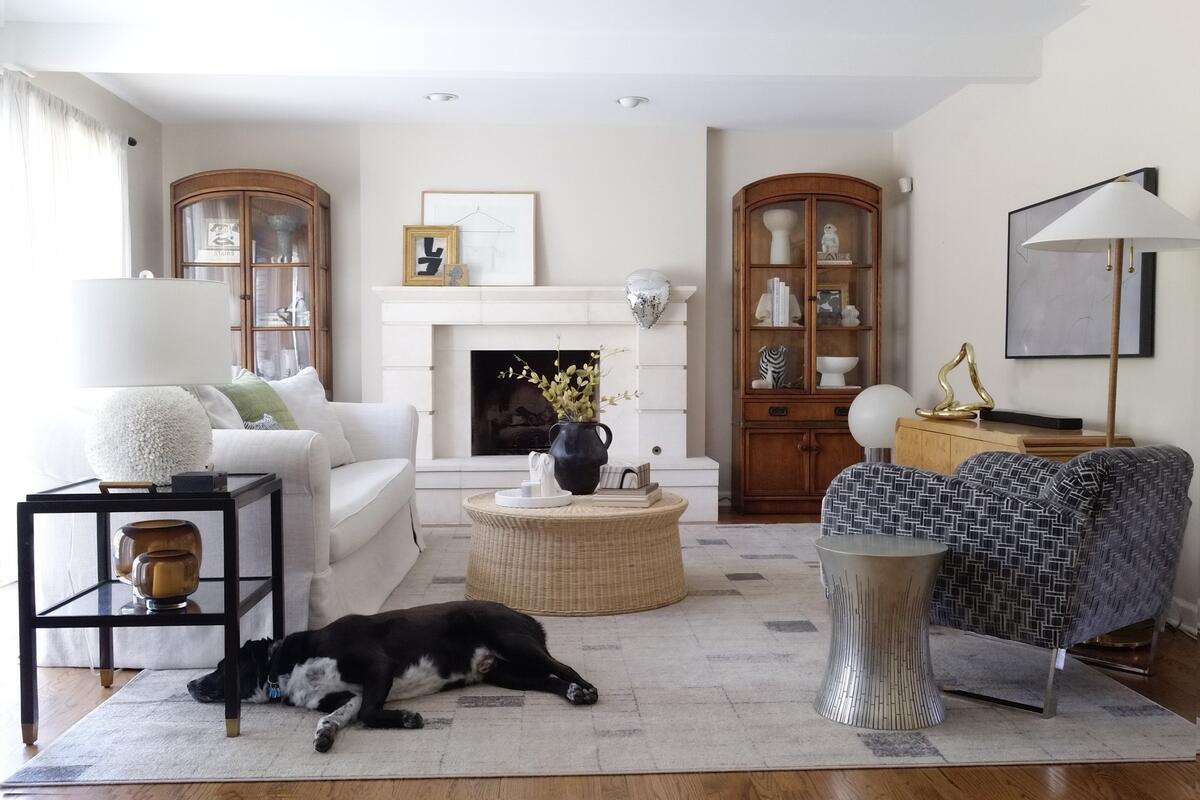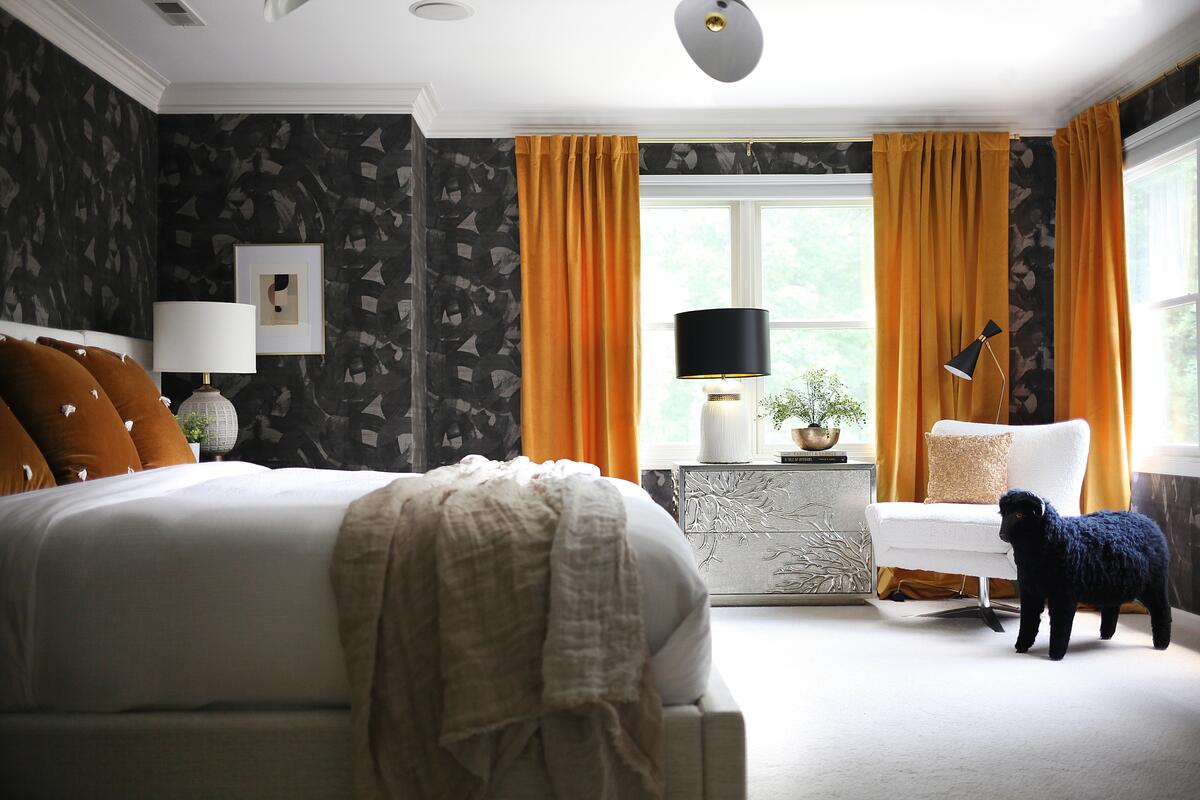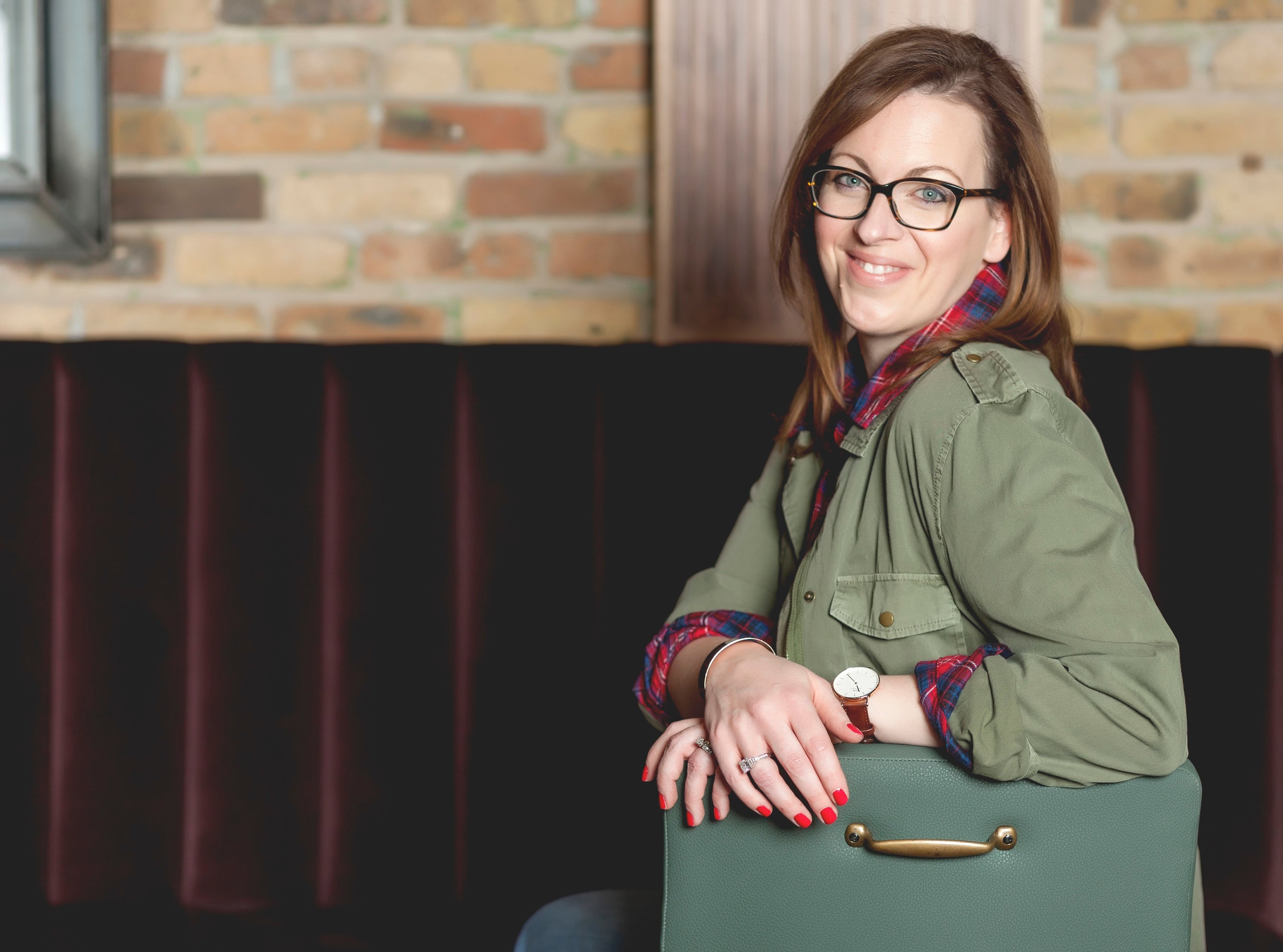In Ask an Influencer, Business of Home explores the creator economy. This week, we spoke with Kyla Herbes, the content creator behind @houseofhipstersblog.
For Kyla Herbes, creative meetings became a regular part of the daily schedule from a young age. Her main role? Distracting the designers at work—namely her mom, a professional seamstress for a Chicago interior design and furniture company. “My sister and I would be jumping around on these bolts of fabric while my mom was in a meeting, so she would sit us in front of fabric samples and say, ‘Design your own room,’” says Herbes. “I had no idea that that was going to have such an impact on me, but apparently it did.”
Herbes went on to study graphic design and advertising in college, and spent more than 19 years in the latter industry before becoming creative director at an agency in Chicago. But by 2012, just after the birth of her second daughter, she realized she had lost herself creatively. When her husband suggested she pick up a hobby, social media quickly came to mind—right before she left for maternity leave, her agency had hired a social media intern for the first time, and she was intrigued.
“When I returned to work after three months, I took our intern out for lunch, and I said, ‘OK, teach me all of the things—why is this important?’” says Herbes. “I said [to myself], We don’t have any social media clients right now because this is not at the forefront of their business strategy. However, I can see the vision. I’m going to create my own client.”
Herbes decided to start with herself. She had always had a knack for decorating and antiquing, and as she had just moved into a new house, the timing seemed perfect to document her processes online. The result: a design blog and social media presence called House of Hipsters, which today has more than 124,000 followers on Instagram and 367,000 on TikTok.
Ahead, she shares the yearlong journey to monetize her blog, why repurposing content is a low-effort path to a bigger following, and why designers shouldn’t overlook the power of Facebook to drive new business.
When did you go full-time on social media?
It was 2017. I had gone back and forth [between] my blog, Pinterest and Instagram, and it was like, OK, I know what I’m doing now. Also in 2017, I got laid off. I knew it was coming—we had lost a few clients to bigger agencies; we were a small one. My boss focused a lot on print and email campaigns, and I was like, “This is not good.” He walked into my office and was like, “Hey Kyla … ” and I said, “Oh, my God, is today the day? Are you laying me off?” He said, “I am. I’m so sorry,” and I was like, “Yes!” I was so excited. My husband, not so much—because I came home and said, “I’m going to do this whole blogger, internet, social media thing full-time.” We had just bought a new house; I had just bought a new car. But I had seen what I was [missing out on], because brands were really starting to want to work with social influencers. I knew what the potential was.
What was the trajectory of that growth like?
[It didn’t] grow all at the same time evenly. I would focus on Pinterest for six, eight months to a year, and I would drop everything else. I actually have recently done that with all of social media and focused purely on my blog for the last year—which seems like a really weird thing to do, but I did it. When I teach social media at conferences and things like that, it’s this [idea of]: Focus on one [platform]. If you try to focus on all of them at the same time, you’re going to lose your marbles. But basically, one platform grew, and then I would stop and try to grow another platform. I feel like I’m finally at the point where I’m managing all of them without totally dropping plates.
What made you decide to focus on your blog last year?
During the pandemic, everything shut down and TikTok was new, and a lot of people became famous overnight. Super talented, amazing people like Emily Rayna got 3 million followers overnight, and I’m going, “Wait, what about me? I’ve been working at this for so long.” That was frustrating because becoming TikTok famous really changed the social media influencer niche—there are so many more people out there [now]. Fast-forward to this year, going into what everybody said was going to be a recession, I didn’t think I was going to have enough brand deals to pay all of my bills, and I don’t want to rely solely on brand deals. So I needed to get people coming to my blog, and I needed an advertising platform, and I needed to up my game in affiliate linking. That’s what I did.

What was that process like?
To get on to these advertising platforms, you have to have a very large volume of traffic coming in from Google every month—and to get that, you have to learn SEO. I hired an SEO strategist, and I worked with him for about 18 months. I randomly met him on Clubhouse during the pandemic in an SEO room, and he gave me an audit. We took my blog from basically zero views to over 50,000 views in a matter of eight or nine months. It was [about] learning keyword strategies and all sorts of stuff. [Early on] it did get to the point where I was like, “This is not going to work, and I should just give up.” One day, the Google gods shined down on my site, and it just took off and started growing, growing, growing. I applied for my advertising platform in August, and I was accepted. All of this has come to a head, and now I’m like, “It’s time to pivot back to your Instagram and TikTok and nurture those communities again,” because I know I’ve been lacking in that department. That’s my new thing: taking all of this and wrapping my head around it and going, “OK, how does this all work together?” Now it’s almost like House of Hipster has become a small media company for influencing.
Has your content strategy changed as well?
Everything that I used to write about was very personal, and it has lost a bit of that personality, because it has become a bit more informative rather than all about me—but I think that’s important, because it’s part of creating that community of interest. It’s still very helpful and authentic, as far as home decor and things that are important to me, but it’s also based a lot on trends. Take High Point Market, for example, where we saw so many curves. I recently found these arched cabinets on Facebook Marketplace. Everybody asks, “Where are they from?” And I have to say: “They’re vintage, by Hickory Chair. You can go on 1stDibs, but they cost a million dollars. Sorry, that is not the answer I know you want—however, on my website, I do have a blog-post roundup of [more affordable] arched cabinets from my favorite furniture companies.” I can push people to the blog from social media, but it’s not, “Swipe up for this, swipe up for that.” I’ve never been pushy on sales, and I feel like I’m the anti-influencer sometimes because I don’t want to sell a product. It really has to be authentic, and something that I have in my house.
What does your business look like?
I have speaking events, I have my blog—which has the ad platform on it, and now that’s 100 percent monetized. I could literally walk away from it right now and still have it make a good amount of money every month, which is awesome. It gives me a whole lot more freedom, which was the goal over the last year. And then also affiliate linking, which also comes through with Google traffic. For example, the arched cabinet posts—pretty much all of those [products] are affiliate links, so if someone were to buy one, I would get a small percentage of that sale. And then, obviously, there are brand deals.
Have you had any viral moments?
I did an introduction where I said, “Hi, I’m Kyla. I wrote a blog called House of Hipsters, and now I’m here on TikTok showing you how to do all things home decor.” It went nuts. It went bananas. That was great because it was an introduction to who I am, and [I gained], like, 100,000-plus followers overnight. It was mind-blowing when it happened. I was like, “What do I do now?” Sometimes it’s good, but actually going viral can be really scary, and you kind of want to hide. I wanted to hide. That’s a lot of people. All of a sudden, they’re in your house, and they know your name and they know your website, where they can look back on stuff from 2013—and a lot of personal things are written on there. It was a lot to wrap my head around.
There was another [viral post]—there’s an auction house in Chicago owned by a family that I happen to know and love. They had a really important auction coming up, and it was actually for another friend of mine whose shop was closing here in Barrington. I said, “Let me see what I can do, because they both have helped me out with vintage stuff.” [I made a video saying], “I’m going to share with you my secret source for vintage,” and it picked up almost a million views. It literally changed their business; the woman was like, “I can’t believe this, but family members from the other side of the United States are sending us this video.” And it wasn’t just that their TikTok grew—it actually crossed over to Instagram growth as well. It was really awesome, and I was super happy for them.
I’ve also recently [helped sell] two houses. [One was] down the street from me—a midcentury modern house that … was really rough inside: shag carpeting still in the bathroom, the original lighting, the original kitchen—it was a bachelor pad, and he even had one of those folding lawn chairs in his bedroom. [You] had to see past a lot. A friend of mine was the Realtor, and another friend was a [midcentury modern fanatic], so I asked if we could pop in. As a thank-you for letting my friend check it out, I posted a TikTok [about the place]. That night, she had an offer, and it actually happened to be quite a famous person. There was another [local property] that I wanted to purchase, and it had a conversation pit in it. My husband was like, “Absolutely not. We have two kids that are going to be headed to college in the next few years. We can’t take on this project right now.” So I said, “Fine, I’ll put it on my TikTok.” That one sold within four days.
Do you work with management?
I work with an agency called Jabberhaus. I toyed with it for a long time, but it definitely makes life easier, because negotiating the brand deals can take time, and this takes that entirely out of my realm so I can just focus on creative work.
The agency is also [talking directly] to the brand. … A brand reaches out to you and says, “We want to work with you,” and you’re like, “OK, great. Here’s my agency,” and never talk to them again. It’s great because I can focus on my creativity, but you’re losing part of those relationships. I’ve learned that you can go back and say, “I have another great idea for this,” and they’ll obviously go back and repitch that, but it’s definitely a balancing act. You’ve got to hold your weight all of a sudden; you’re accountable.

Do you have any advice for designers looking to improve their engagement?
If it’s on Instagram, do both Reels and stills, for sure. Whatever you’re putting out for video—and stills as well—put it on Pinterest, too, and have it link back to your website with your portfolio. Also, push all that stuff out on Facebook. A lot of people think Facebook is kind of old and stodgy, but it still outperforms so many times. The engagement is awesome, and you still get traffic to your website. Don’t think Facebook doesn’t have that power, because it does. I would just repurpose all of that content across any channel. I’m not focused on YouTube at all, for example, but I take my short-form videos and post them there as Youtube Shorts. I think I have a whole 3,000 followers on there.
Figure out ways to tie [your social posts] to your website. If somebody is Googling trying to find a designer in their area, they may land on your website. The first thing they’re going to do is see how your personality is on Instagram. I would show that personality—be camera-facing. Make captions that are more than just “This is a pretty room.” Try to connect with that audience. If you’re doing a video, do it with purpose; not just [for] the meme. If it’s a book deal that you want, start talking about things, start teaching things, start showing different things that you want to tell if you eventually write a book. Or if you have products—like Pure Salt has their own shop, for example—show how you use them in interesting ways, how you would arrange things for the perfect kitchen, or something like that.
Always find a way to push [your content] back to your business, rather than just posting dance [videos] or something. Those are fun, but I have a friend who went viral for one of those, and half of her audience is now overseas. That’s where it went viral. Now brands are like, “Well, your audience is over there, in a different country.” That doesn’t help a designer—unless maybe it’s in Paris, and you want to redesign a Paris flat, then it will work out perfectly. But I would find a balance between meme-funny and posting with purpose.
What’s the biggest challenge for you on social media right now?
I compare a lot. I compare myself to other [formerly] small accounts that have become bigger accounts. I compare what I have in my house to somebody else’s home, or if somebody has better engagement than I do, I get frustrated. [The challenge is in] trying not to get frustrated and not comparing yourself. I have a blog that is now on an ad platform and monetized, and that’s awesome—[I have to tell myself], that’s what you’re focused on.
Do you have any strategies when it comes to social media fatigue?
I do take breaks. The guy I was working with for SEO and as a business strategist, he was saying: “I think you need to, every other week, just go on an outing. Just you. Are you going to go to the art museum down in Chicago? Are you going to go to the city so you can just walk through different shops? Are you going to go shopping for clothes?” It’s just seeing what trends are out there and taking that break and exploring and knowing that it’s feeding your brain creatively.




























